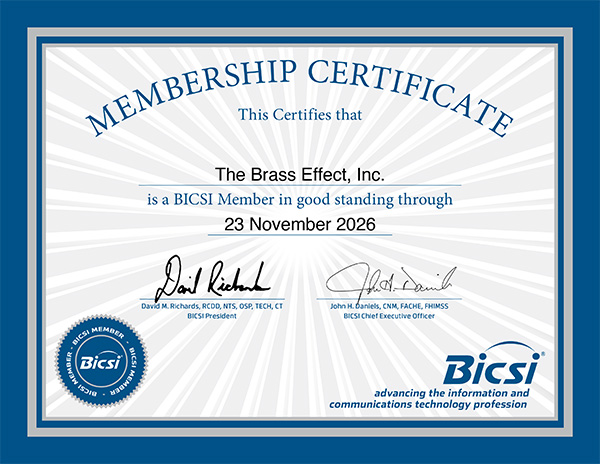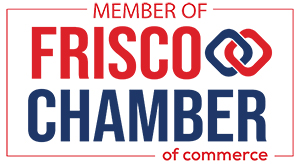Structured Data Cabling
Division 27 Structured Cabling & Low-Voltage Networking – Frisco & DFW
Reliable structured cabling for schools, cities, and growing businesses in Frisco and across DFW. We design and install Division 27 infrastructure that keeps your classrooms, offices, and facilities connected for Wi-Fi, phones, security, A/V, and cloud.
Infrastructure That Everything Else Depends On
No data cabling means no internet, no phones, no email, and no work. Your network infrastructure is the quiet backbone that every system relies on – from Wi-Fi and VoIP to security cameras, access control, A/V, and future AI and analytics.
The Brass Effect (TBE::INFRASTRUCTURE) designs and installs structured cabling systems that:
- Support today’s bandwidth needs and tomorrow’s upgrades
- Follow industry standards and best practices
- Integrate cleanly with your switching, security, A/V, and cloud strategy
We serve organizations that can’t afford guesswork with their cabling – especially schools and public-sector environments where uptime and safety matter.
Who We Serve
The Brass Effect provides structured cabling, data cabling, and low-voltage networking for:
- K–12 school districts and higher-ed campuses
- Cities, counties, and public safety facilities
- Growing SMBs and multi-site offices across the DFW Metroplex
Whether you’re planning a bond project, renovating a facility, or refreshing network closets, we design cabling systems that support:
- Wi-Fi and access points
- VoIP and business phone systems
- Security cameras and access control
- Classroom and conference room A/V
- Cloud and data center connectivity
If you’re planning a structured cabling or low-voltage project in Frisco or the DFW area, start here:
One Vendor for Cabling, Security & A/V
Most organizations don’t want three different vendors for cabling, security, and A/V.
The Brass Effect is built to handle:
- Structured cabling and data cabling (TBE::INFRASTRUCTURE)
- Security cameras & access control cabling and infrastructure (TBE::SECURITY)
- Classroom, conference room, and training A/V including Extron-certified integration (TBE::A/V)
When projects also require internet circuits, voice, cloud, or outsourced IT services, we bring in specialist providers through our partner network while remaining your single point of contact under TBE::IT.
Get Your Cabling Right the First Time
A professional, standards-based cabling installation is the foundation of a properly performing network. Cutting corners on cabling shows up later as:
- Unstable Wi-Fi and dropped connections
- Mysterious performance issues and slow apps
- Cameras and access control devices that won’t stay online
- Higher costs every time you renovate or add new technology
TBE::INFRASTRUCTURE designs and installs cabling across Frisco, Celina, Plano, Allen, Prosper, Little Elm, McKinney, Richardson, and Dallas with:
- Certified installers and tested terminations
- 5G-ready, IoT- and PoE-capable designs
- Clear documentation and labeling that your IT and vendors can rely on
Understanding the Different Classes of Data Cabling
Choosing the right cable category affects performance, distance, and future upgrade paths. We design and install the right mix of Cat5e, Cat6, Cat6A and above based on your applications, building layout, and budget.
Cat5e
Up to 1 Gbps, suitable for many office and classroom networks; cost-effective for basic data, voice, and standard video.
Cat6
Higher bandwidth and performance, supports up to 10 Gbps over shorter runs; a strong choice for new builds and heavier workloads.
Cat6A
Up to 10 Gbps over full distances, better noise performance; ideal for high-density Wi-Fi, uplinks, and long-term backbone in many environments.
Cat7 / Cat8
Specialty use in high-performance or data center environments; used where ultra-high speeds and specific conditions justify the cost.
Each type of data cable has unique characteristics and applications:
- Cat5e: "Category 5 enhanced" cables are an advancement over Cat5, supporting bandwidths up to 100 MHz. This means they can efficiently handle data transfer speeds up to 1 Gigabit per second (Gbps) over distances as long as 328 feet. Cat5e is a versatile choice for various applications, including small business networks and residential setups. It's well-suited for everyday internet access, telephony, and standard video conferencing needs. The 100 MHz bandwidth allows for the efficient handling of data and voice services, making it a reliable and cost-effective solution for most modern office environments and home networks.
- Cat6: "Category 6" cables are a significant step up from Cat5e, offering increased bandwidth up to 250 MHz. This higher bandwidth capacity enables Cat6 to support data transfer speeds up to 10 Gbps over distances up to 180 feet. The enhancement makes Cat6 ideal for environments that demand higher performance, such as multimedia streaming, high-definition video conferencing, and extensive networked applications commonly found in medium-sized businesses. The 250 MHz bandwidth allows for improved signal quality and reduced interference, crucial for applications requiring stable and high-speed network connections.
- Cat6A: "Category 6 Augmented" cables further extend the capabilities of Cat6, offering doubled bandwidth capacity of up to 500 MHz. This means Cat6A can support high-speed data transmission up to 10 Gbps over longer distances of up to 328 feet. Cat6A is particularly effective in large-scale network environments like data centers, where maintaining high-speed connections over extended runs is essential. Its improved design significantly reduces crosstalk and interference, making it a superior choice for densely packed network configurations, such as in high-resolution medical imaging facilities and professional broadcasting studios, where maintaining signal integrity is crucial.
- Cat7: "Category 7" cables provide an even higher level of performance, with a bandwidth capacity of up to 600 MHz. This allows Cat7 to support data transfer speeds up to 10 Gbps over distances of up to 328 feet. Commonly used in data centers and high-performance networking environments, Cat7 is suited for applications that require the fastest and most stable connections.
- Cat8: "Category 8" cables are designed for the most advanced networking environments. They support a bandwidth of up to 2000 MHz (2 GHz) and speeds up to 25-40 Gbps, but over shorter distances of up to about 98 feet. This makes Cat8 ideal for high-speed data centers, research institutions, and large enterprises with advanced networking requirements. Its design focuses on professional and data center applications where maintaining ultra-high-speed connections is vital.
| Cable Type | Bandwidth | Max Speed | Distance | Applications |
|---|---|---|---|---|
| Cat5e | 100 MHz | 1 Gbps | 328 feet | Small business networks, residential setups, basic internet services, VoIP, home video streaming |
| Cat6 | 250 MHz | 10 Gbps | 180 feet | Multimedia streaming, video conferencing, HD video surveillance, PoE applications, Gigabit Ethernet networks |
| Cat6A | 500 MHz | 10 Gbps | 328 feet | Data centers, medical imaging, high-speed wireless APs, NAS devices, industrial applications |
| Cat7 | 600 MHz | 10 Gbps | 328 feet | Data centers, advanced networking, high-speed computing servers, multi-gigabit Ethernet, large-scale commercial installations |
| Cat8 | 2000 MHz | 25-40 Gbps | 98 feet | High-speed data centers, research institutions, large enterprises, high-performance computing clusters, backbone networks |
We’ll help you choose the right cable types for each part of your building so you’re not over-spending in some areas or under-building critical runs.
Exploring Fiber Optic Cabling Options
Fiber optic cabling is used for high-speed backbones, long-distance runs, and connections that copper can’t realistically support. We design both single-mode and multimode fiber paths based on distance, bandwidth, and future growth.
- Single-Mode Fiber (OS1/OS2) – Designed for long-distance, high-speed links such as building-to-building, campus backbones, and metro or outdoor runs. Supports very high bandwidth over miles, with OS1 typically used indoors and OS2 optimized for outdoor and long-haul applications.
- Multimode Fiber (OM3/OM4/OM5) – Used for shorter, high-bandwidth links within and between buildings, data closets, and data centers. Ideal for high-speed connections inside facilities where distances are shorter but performance demands are high.
| Fiber Type | Bandwidth | Max Speed | Distance | Common Applications |
|---|---|---|---|---|
| Single-Mode Fiber | High | Up to 100 Gbps | Up to 25 miles | City-wide internet, university campuses |
| OS1 Single-Mode Fiber | High | Up to 100 Gbps | Up to 2 km (indoor) | Indoor, campus backbones, data centers |
| OS2 Single-Mode Fiber | High | Up to 100 Gbps and beyond | Up to 25 miles (outdoor) | Outdoor, long-haul networks, metropolitan areas, large campus inter-building connections |
| Multi-Mode Fiber | High | Up to 100 Gbps | Up to 2000 feet | Office buildings, data centers, local area networks (LANs) |
| OM3 Multimode Fiber | High | Up to 10 Gbps | Up to 1000 feet | Gigabit Ethernet, 10 Gigabit Ethernet |
| OM4 Multimode Fiber | High | Up to 10 Gbps | Up to 1000 feet | Gigabit Ethernet, 10 Gigabit Ethernet, and applications requiring higher bandwidth |
| OM5 Multimode Fiber | High | Up to 100 Gbps | Up to 4400 feet | High-speed data centers, applications requiring very high bandwidth |
**OM (Optical Multimode) is not applicable to Single-Mode Fiber. OM is a classification used specifically for Multimode Fibers to denote different generations and their respective performance characteristics. Single-Mode Fiber operates differently from Multimode Fiber and doesn't use the OM classification.
In contrast, OS (Optical Single-mode) classifications, such as OS1 and OS2, refer to the construction and performance standards of single-mode fibers. OS1 is typically used for indoor applications, characterized by its suitability for tighter bends and shorter runs. OS2 is designed for outdoor use and long-haul communications, offering lower attenuation and support for greater distances. Unlike OM-rated fibers, OS-rated fibers are optimized for high-speed, long-distance transmission using a single light mode.
In the context of Multimode Fiber, OM designations like OM1, OM2, OM3, OM4, and OM5 are used to indicate the fiber's bandwidth and performance capabilities, with each generation offering improvements in terms of bandwidth and distance capabilities.
Whether you need copper, fiber, or a hybrid design, TBE can design and install the backbone and horizontal cabling that keeps your network fast and reliable.
Our Process
Most tenants and organizations don’t handle structured cabling projects every day. We do. Our goal is to make the process as simple and predictable as possible.
1. Walkthrough and Scope of Work
We start with a walkthrough and review of any plans you have. We document rooms, drops, closets, and special requirements so we’re all clear on scope.
2. Customized Proposal
We build a cabling design and proposal aligned with your specifications, standards, budget, and timeline. When applicable, we align pricing with TIPS or other co-op contracts so procurement is straightforward.
3. Schedule, Install & Test
We schedule around your operations, install to industry standards, test and label all cables, and provide documentation your IT team can use going forward.
When you’re ready to begin, use Start Your Cabling Request to kick off the process.
What We Install
We specialize in structured cabling and low-voltage infrastructure for commercial and public-sector environments across Dallas–Fort Worth, including Frisco, Plano, Allen, Celina, Prosper, Little Elm, and McKinney.
Copper Data Cabling
Cat5e, Cat6, Cat6A and above for workstations, WAPs, phones, cameras, and A/V – designed for performance and labeled for long-term support.
Optical Fiber Cabling
Single-mode and multimode fiber for building backbones, IDF/MDF uplinks, and campus or multi-building connectivity.
Access Control & Security Cabling
Cabling infrastructure for access control devices, security cameras, and related low-voltage equipment as part of TBE::SECURITY projects.
A/V & Classroom Cabling
Structured cabling to support classroom A/V, conference rooms, and collaboration spaces as part of TBE::A/V designs.
Need a Quick Office Cabling Quote?
If you’re planning a small to mid-sized office or suite, we can often provide ballpark pricing based on drop counts.
As a general guideline, many structured cabling projects fall in the $250–$450 per drop range, depending on:
- Cable type (Cat5e, Cat6, Cat6A, fiber, etc.)
- Ceiling height and accessibility
- Building conditions and pathway requirements
- Hardware and materials (racks, patch panels, jacks, etc.)
This isn’t a final quote, but it gives you a realistic starting point so we don’t waste your time.
For larger or multi-site projects, use Start Your Cabling Request to provide more complete project details.





